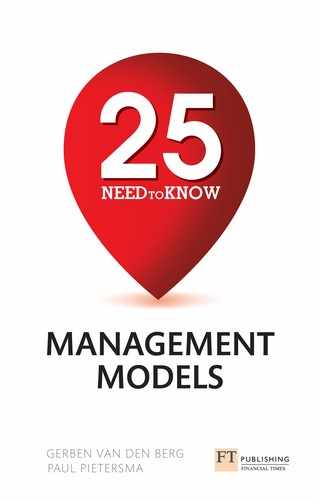Competing values
- Why use it? The competing values framework is a model for judging the effectiveness of organisations, but it can also be used to assess and define supervision and management development programmes.
- What does it do? Using the model you will gain a better understanding of organisational effectiveness criteria. Based on three organisational dilemmas, your organisation is plotted against one of four basic models of (organisational and managerial) effectiveness.
- When to use it? In an organisational context, the framework can be used in four ways: to develop supervision and management development programmes, to understand various organisational functions and processes, to examine organisational gaps and to diagnose an organisation’s culture.
- What question will it help you answer? How can I increase my organisational and managerial effectiveness? What are the unseen values for which people and organisations live and die?
The big picture
The competing values framework is a model for judging the effectiveness of organisations (Quinn and Rohrbaugh, 1983), but it can also be used to assess and define supervision and management development programmes. The study by Quinn and Rohrbaugh (1983) was an attempt to gain a better understanding of organisational effectiveness criteria, which resulted in a multi-dimensional scaling or spatial model with three dimensions (Figure 22.1):
- internal vs external focus of the organisation;
- flexibility vs stability of the organisation;
- process vs goals orientation (the means to achieving the end).

Figure 22.1 Competing values
Source: based on Quinn and Rohrbaugh (1983)
When to use it
In an organisational context, the framework can be used in four ways:
- to develop supervision and management development programmes;
- to understand various organisational functions and processes;
- to examine organisational gaps;
- to diagnose an organisation’s culture.
How to use it
The dimensions of the model reflect well-known organisational dilemmas. The first dimension (internal vs external organisational focus) represents a basic organisational dilemma in which, at one end of the scale, the organisation is viewed as a socio-technical entity, and at the other as a logically designed tool for accomplishing business goals.
Flexibility vs stability is another basic organisational dilemma. Order and control do not mix well with innovation and change. Many social theorists have (successfully) argued for authority, structure and coordination, while others have found evidence for individual initiative and organisational adaptability.
Finally, a study of organisational effectiveness cannot be complete without observation of the tendency of means, methods, procedures and rules to become functionally autonomous, i.e. to become goals in themselves.
The integration of these dimensions results in four basic models of organisational effectiveness:
- Internal process model – based on hierarchy, with an emphasis on measurement, documentation and information management. These processes bring stability and control. Hierarchies seem to function best when the task at hand is well understood and when time is not an important factor.
- Open systems model – based on an organic system, with an emphasis on adaptability, readiness, growth, resource acquisition and external support. These processes bring innovation and creativity. People are not controlled but inspired.
- Rational goal model – based on profit, with an emphasis on rational action. It assumes that planning and goal-setting results in productivity and efficiency. Tasks are clarified, objectives are set, and action is taken.
- Human relations model – based on cohesion and morale, with an emphasis on human resources and training. People are seen not as isolated individuals, but as cooperating members of a common social system with a common stake in what happens.
While the models seem to be four entirely different perspectives or domains, they can be viewed as closely related and interwoven. They are four sub-domains of a larger construct: organisational and managerial effectiveness. The four models in the framework represent the unseen values for which people, programmes, policies and organisations live and die.
The final analysis
The debate surrounding the model that describes organisations and the issues they face is ongoing. In an effort to derive a framework for organisational analysis, Quinn and Rohrbaugh approached a large number of organisational researchers and experts to determine the key dimensions of organisational issues. The fact that the three dimensions of the model so closely describe three major areas of debate and research indicates that the authors have been quite successful in their effort to provide a framework for organisational effectiveness.
In anticipation of criticism, Quinn and Rohrbaugh agree that the spatial model is a type of oxymoron: a combination of seemingly contradictory and simple concepts. However, the theoretical paradoxes are not necessarily empirical opposites. They argue that an organisation might be cohesive and productive, or stable as well as flexible. Does its apparent simplicity limit the scope of the model? Quinn and Rohrbaugh would seem to argue the contrary, as they state that the process of creating the model is, in itself, productive. Quinn and Rohrbaugh present a number of alternative methods for comparing and describing their model; for instance, using Parson’s functional prerequisites model, in which core values, coordination mechanisms and organisational structures are presented.
References
O’Neill, R.M and Quinn, R.E. (1993) ‘Editor’s Note: Applications of the competing values framework’. Human Resource Management 32(1), 1–7.
Quinn, R.E. and Rohrbaugh, J. (1983) ‘A spatial model of effectiveness criteria: Towards a competing values approach to organisational analysis’. Management Science 29(3), 363–377.
Quinn, R.E. (1988) Beyond Rational Management: Mastering the Paradoxes and Competing Demands of High Performance. San Francisco: Jossey-Bass.
